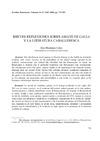Please use this identifier to cite or link to this item:
https://accedacris.ulpgc.es/jspui/handle/10553/72049
| DC Field | Value | Language |
|---|---|---|
| dc.contributor.author | Munteanu Colan, Danut | en_US |
| dc.date.accessioned | 2020-05-05T16:01:37Z | - |
| dc.date.available | 2020-05-05T16:01:37Z | - |
| dc.date.issued | 2008 | en_US |
| dc.identifier.issn | 0210-4911 | en_US |
| dc.identifier.other | WoS | - |
| dc.identifier.uri | https://accedacris.ulpgc.es/handle/10553/72049 | - |
| dc.description.abstract | The chivalresque novel appears in Western Europe in the twelfth to fourteenth centuries with roman courtois, in the atmosphere of the radical change operated in the political, socioeconomic and cultural life, identified like the Renaissance. In Spain, the Renaissance is delayed, due to particular conditions (the Reconquest) and, consequently, the chivalresque novel, like genre, appears hardly at the beginning of the sixteenth century, although there are several works known with chivalric elements considered antecedent of the chivalresque romance. Amadis of Gaul is the most representative and fixes the model of the genre in the Iberian Peninsula. Inspired by the Breton cycle, the novel has, undoubtedly, its own identity and personality, that individualizes it and confer it a separate place in the European chivalresque literature panorama. | en_US |
| dc.description.abstract | La novela de caballería aparece en la Europa occidental en los siglos XII-XIV con el roman courtois, en el ambiente del cambio radical operado en la vida política, socioeconómica y cultural, identifi cado como el Renacimiento. En España, el Renacimiento es tardío, debido a unas condiciones particulares (la Reconquista) y, consecuentemente, la novela de caballería, como género, aparece apenas a comienzos del XVI, aunque se conocen varias obras con elementos caballerescos consideradas antecedentes de la novela de caballería. Amadís de Gaula es la más representativa y fi ja el modelo del género en la Península Ibérica. Inspirada en el ciclo bretón, la novela tiene, indudablemente, identidad y personalidad propias, que la individualizan y le confieren un lugar aparte en el panorama de la literatura caballeresca europea. | en_US |
| dc.language | spa | en_US |
| dc.relation.ispartof | Estudios Romanicos | en_US |
| dc.source | Estudios Románicos [ISSN 0210-4911], v. 16-17 (1), p. 779-789 | en_US |
| dc.subject | 6202 Teoría, análisis y crítica literarias | en_US |
| dc.title | Breves reflexiones sobre Amadís de Gaula y la literatura caballeresca | en_US |
| dc.title.alternative | Brief Reflections On Amadis De Gaula And Chivalric Literature | en_US |
| dc.type | info:eu-repo/semantics/Article | en_US |
| dc.type | Article | en_US |
| dc.identifier.isi | 000210235300017 | - |
| dc.identifier.eissn | 1989-614X | - |
| dc.description.lastpage | 789 | en_US |
| dc.identifier.issue | 1 | - |
| dc.description.firstpage | 779 | en_US |
| dc.relation.volume | 16-17 | en_US |
| dc.investigacion | Artes y Humanidades | en_US |
| dc.type2 | Artículo | en_US |
| dc.contributor.daisngid | 5338289 | - |
| dc.description.numberofpages | 11 | en_US |
| dc.utils.revision | Sí | en_US |
| dc.contributor.wosstandard | WOS:Colan, DM | - |
| dc.date.coverdate | 2008 | en_US |
| dc.identifier.ulpgc | Sí | es |
| dc.description.sellofecyt | Sello FECYT | |
| dc.description.esci | ESCI | |
| item.grantfulltext | open | - |
| item.fulltext | Con texto completo | - |
| crisitem.author.dept | GIR Sociolingüística, fonética acústica y lingüística aplicada a la enseñanza | - |
| crisitem.author.parentorg | Departamento de Filología Hispánica, Clásica y de Estudios Árabes y Orientales | - |
| crisitem.author.fullName | Munteanu Colan,Danut | - |
| Appears in Collections: | Artículos | |
Items in accedaCRIS are protected by copyright, with all rights reserved, unless otherwise indicated.
